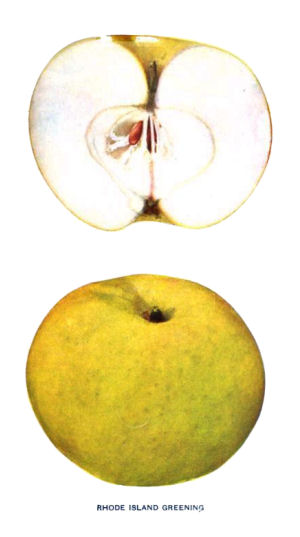
HOME
INTRO
SYMBOLS
ALMANAC
ECONOMY
GEOGRAPHY
STATE MAPS
PEOPLE
FORUM
NEWS
COOL SCHOOLS
STATE QUIZ
STATE LINKS
BOOK STORE
MARKETPLACE
GUESTBOOK
CONTACT US

Rhode Island State Fruit: Rhode Island Greening Apple
Photography: John J. Mosesso/NBII.Gov
Rhode Island Law
The following information was excerpted from the State of Rhode Island General Laws, Title 42, Chapter 1042-4, Section 42-4-13
TITLE 42 State Affairs and Government
CHAPTER 42-4 State Emblems
SECTION 42-4-13
§ 42-4-13 Official state fruit. -- The variety of apple known as the Rhode Island greening is hereby designated as the official state fruit for the state.
Sources...
State of Rhode Island General Laws. State of Rhode Island General Assembly. 2009. 31 March 2009
Shearer, Benjamin F. and Barbara S. State Names, Seals, Flags and Symbols: A Historical Guide Third Edition, Revised and Expanded. Westport, Conn: Greenwood Press, 3 Sub edition, 2001.
Additional Information
Rhode Island Greening Apples: Facts from specialtyproduce.com.
Rhode Island Greening: Apple Journal Photo Gallery.
Apple (Malus spp. Mill.): Virginia Tech, College of Natural Resources: Department of Forestry.
Malus Mill. (Apple): USDA, NRCS. 2004. The PLANTS Database, Version 3.5 (http://plants.usda.gov). National Plant Data Center, Baton Rouge, LA 70874-4490 USA.
Malus P. Mill.: Integrated Taxonomic Information System (ITIS) Here you will find authoritative taxonomic information on plants, animals, fungi, and microbes of North America and the world.
State Fruit: Complete list of official state fruit.
More symbols & emblems: Complete list of official Rhode Island state symbols.

The Story of the Apple
Barrie E. Juniper & David J. Mabberley
The Story of the Apple, by Barrie E. Juniper and David J. Mabberley. 240 pages. Timber Press, Incorporated (August 1, 2006) Where did the apple come from and why is the large, sweet, cultivated apple so different-in both size and taste-from all other wild apple species? The Story of the Apple will fascinate gardeners who wish to know more about the origin and natural history of the plants that they grow in their yards or orchards, researchers and students, and anyone with an interest in diet, well-being, and the benevolent effects of plants on the emergence of humankind.

The Apple Grower
by Michael Phillips
The Apple Grower: Guide for the Organic Orchardist , by Michael Phillips. 320 pages. Chelsea Green; 2nd edition (November 30, 2005) The definitive guide to growing apples wisely, naturally, and with gentle impact on the earth. For decades fruit growers have sprayed their trees with toxic chemicals in an attempt to control a range of insect and fungal pests. Yet it is possible to grow apples responsibly, by applying the intuitive knowledge of our great-grandparents with the fruits of modern scientific research and innovation.
The Backyard Orchardist: A Complete Guide to Growing Fruit Trees in the Home Garden, by Stella Otto. 250 pages. Ottographics; Rev Sub edition (January 1, 1995) For every gardener desiring to add apples, pears, cherries, and other tree fruit to their landscape here are hints and solid information from a professional horticulturist and experienced fruit grower. The Backyard Orchardist includes help on selecting the best fruit trees and information about each stage of growth and development, along with tips on harvest and storage of the fruit. Those with limited space will learn about growing dwarf fruit trees in containers.
Growing Fruit (RHS Encyclopedia of Practical Gardening), by Harry Baker, The Royal Horticultural Society. 192 pages. Mitchell Beazley; 3rd edition (March 1, 1999) Produced in association with the Royal Horticultural Society, the titles in this series, which have sold over a million copies worldwide, have become standard works of practical gardening reference. Each book is illustrated with easy-to-follow, step-by-step illustrations that clearly guide the reader through all the essential techniques of successful gardening.
The Omnivore's Dilemma: A Natural History of Four Meals, by Michael Pollan. 464 pages. Penguin Press HC, The (April 11, 2006) The bestselling author of The Botany of Desire explores the ecology of eating to unveil why we consume what we consume in the twenty-first century
In Defense of Food: An Eater's Manifesto, by Michael Pollan. 256 pages. Penguin Press HC, The (2008) In looking toward traditional diets the world over, as well as the foods our families-and regions-historically enjoyed, we can recover a more balanced, reasonable, and pleasurable approach to food. Michael Pollan's bracing and eloquent manifesto shows us how we might start making thoughtful food choices that will enrich our lives and enlarge our sense of what it means to be healthy.
Garden tools from Amazon.com!
 Custom Search
Custom Search



